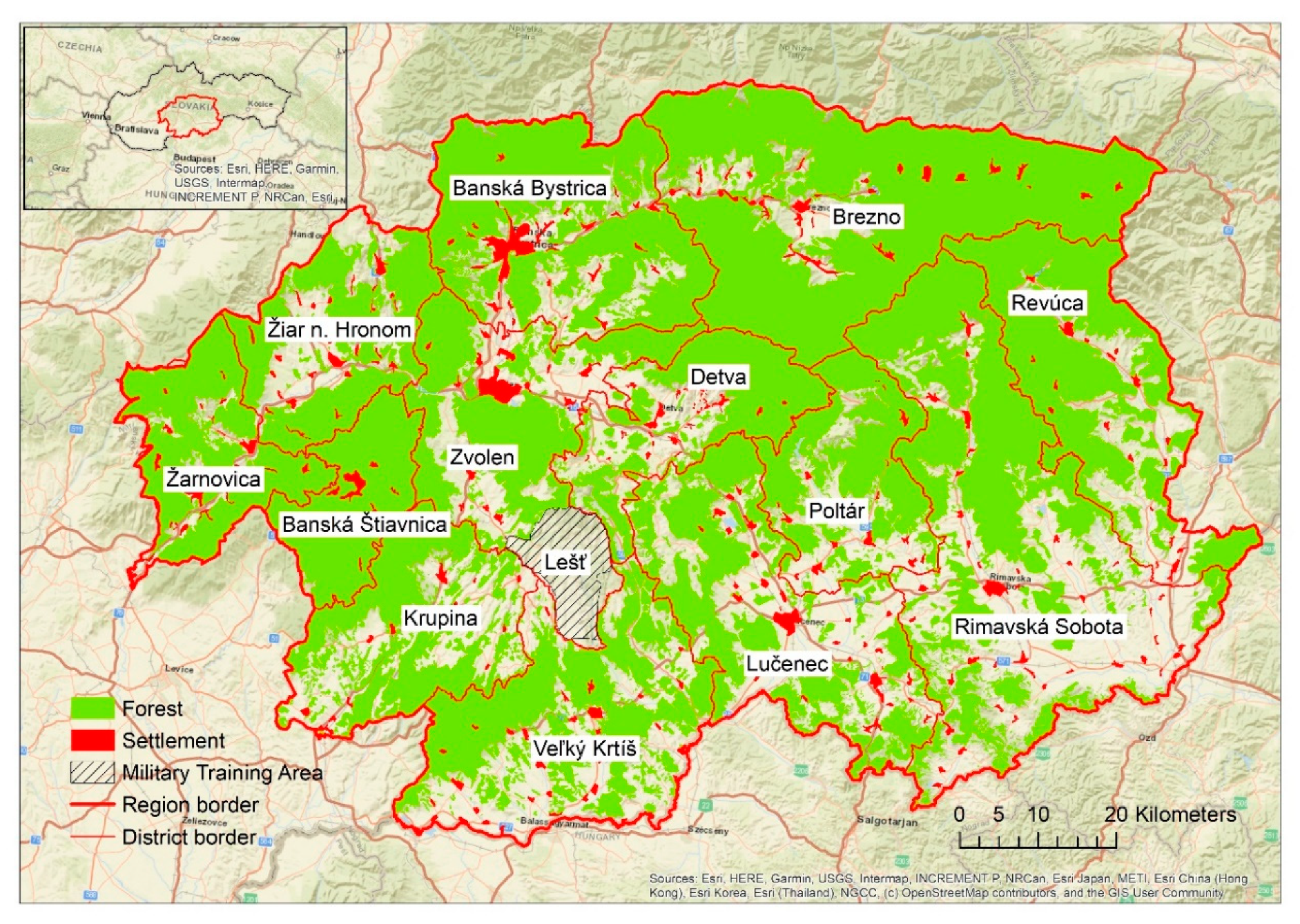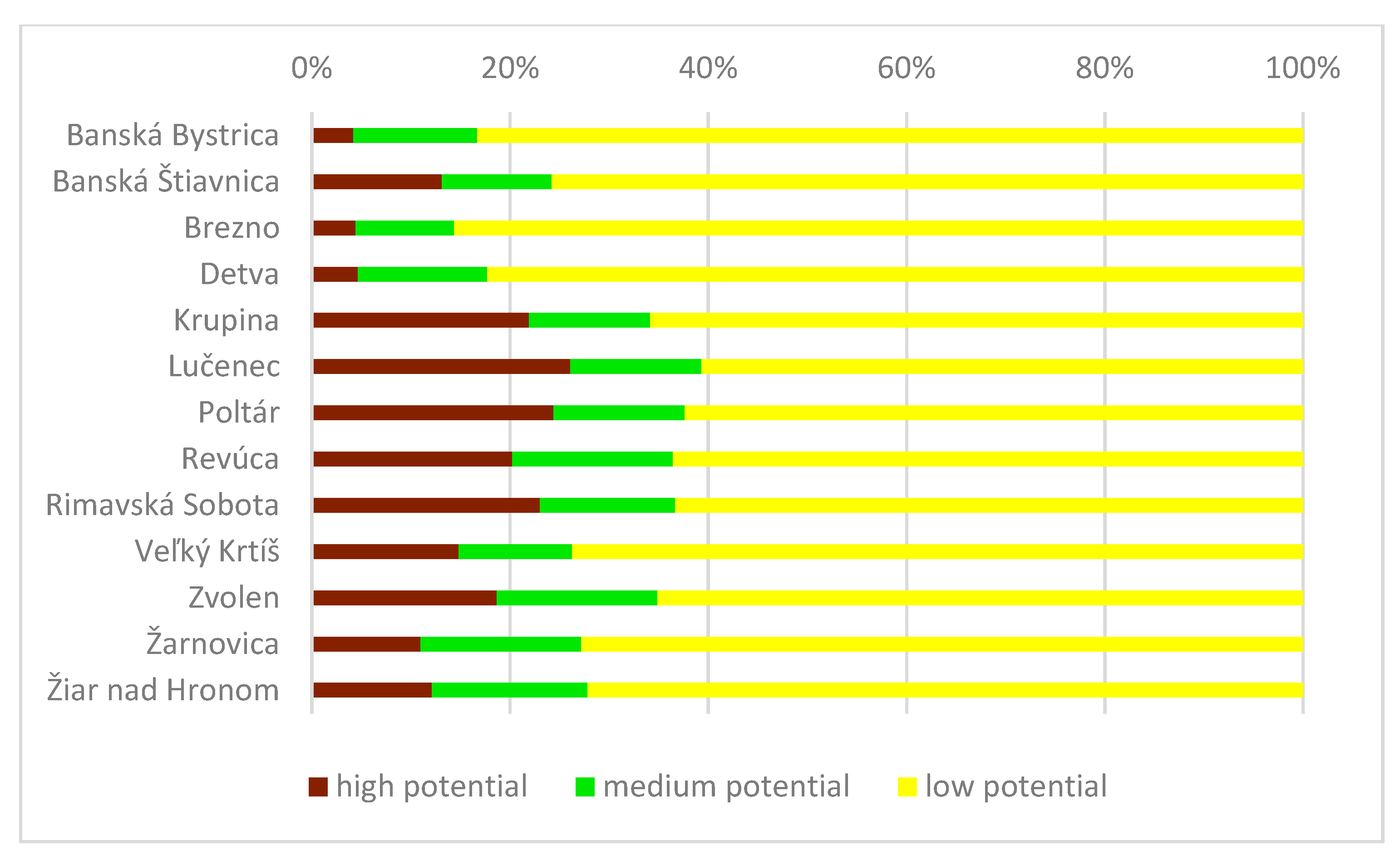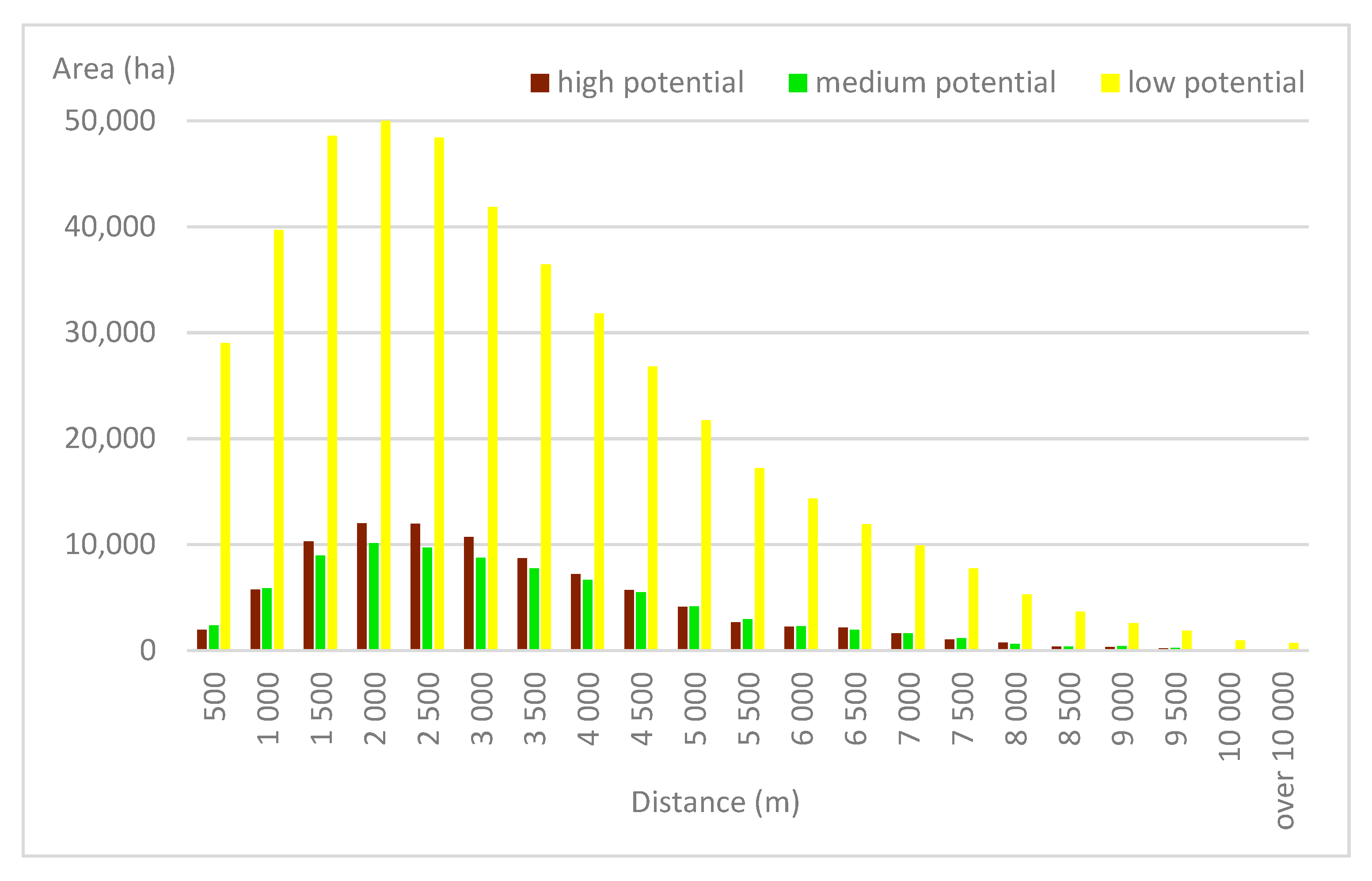Assessing the Potential of Forest Stands for Ectomycorrhizal Mushrooms as a Subsistence Ecosystem Service for Socially Disadvantaged People: A Case Study from Central Slovakia
Abstract
1. Introduction
2. Materials and Methods
2.1. Study Area
2.2. Ectomycorrhizal Mushrooms and their Ecological Preferences
2.3. Spatial Data and Modelling of Potential for Mushroom Occurrence
2.4. Demand and Accessibility for Local Communities
3. Results
3.1. Potential of Forest Stands for Mushrooms Growing
3.2. Demand and Accessibility of Mushroom Sites
4. Discussion
4.1. Modelling and Parameters
4.2. Mushrooming as an Ecosystem Service
5. Conclusions
Author Contributions
Funding
Acknowledgments
Conflicts of Interest
References
- Mikšík, M.; Kunca, V. 1000 Slovenských a českých Húb; Svojtka & Co.: Bratislava, Slovakia, 2015; p. 800. [Google Scholar]
- Heilmann-Clausen, J.; Barron, E.S.; Boddz, L.; Dahlberg, A.; Griffith, G.W.; Nordén, J.; Ovaskainen, O.; Perini, C.; Senn-Irlet, B.; Halme, P. A fungal perspective on conservation biology. Conserv. Biol. 2015, 29, 61–68. [Google Scholar] [CrossRef] [PubMed]
- Kotowski, M.A. Differences between European Regulations on Wild Mushroom Commerce and Actual Trends in Wild Mushroom Picking. Slov. Národop. (Slovak Ethnol.) 2016, 64, 169–178. [Google Scholar]
- Schulp, C.J.E.; Thuiller, W.; Verburg, P.H. Wild food in Europe: A synthesis of knowledge and data of terrestrial wild food as an ecosystem service. Ecol. Econ. 2014, 105, 292–305. [Google Scholar] [CrossRef]
- Łuczaj, Ł.; Nieroda, Z. Collecting and learning to identify edible fungi in southeastern Poland: Age and gender differences. Ecol. Food Nutr. 2011, 50, 319–336. [Google Scholar] [CrossRef] [PubMed]
- Peintner, U.; Schwarz, S.; Mešić, A.; Moreau, P.-A.; Moreno, G.; Saviuc, P. Mycophilic or mycophobic? Legislation and guidelines on wild mushroom commerce reveal different consumption behaviour in European countries. PLoS ONE 2013, 8, e63926. [Google Scholar] [CrossRef] [PubMed]
- Lelley, J.I. Modern applications and marketing of useful mushrooms. Int. J. Med. Mushrooms 2005, 7, 39–47. [Google Scholar] [CrossRef]
- Aldea, J.; Martinez-Peña, F.; Díaz-Balteiro, L. Integration of fungal production in forest management using a multi-criteria method. Eur. J. For. Res. 2012, 131, 1991–2003. [Google Scholar] [CrossRef]
- Haines-Young, R.; Potschin, M.B. Common International Classification of Ecosystem Services (CICES) V5.1 and Guidance on the Application of the Revised Structure; European Environment Agency: Copenhagen, Denmark, 2012; Available online: www.cices.eu (accessed on 20 January 2020).
- García-Nieto, A.P.; García-Llorente, M.; Iniesta-Arandia, I.; Martín-López, B. Mapping forest ecosystem services: From providing units to beneficiaries. Ecosyst. Serv. 2013, 4, 126–138. [Google Scholar] [CrossRef]
- Donnini, D.; Gargano, M.L.; Perini, C.; Savino, E.; Murat, C.; Di Piazza, S.; Altobelli, E.; Salerni, E.; Rubini, A.; Rana, G.L.; et al. Wild and cultivated mushrooms as a model of sustainable development. Plant Biosyst. 2013, 147, 226–236. [Google Scholar] [CrossRef]
- Spina, F.; Cecchi, G.; Landinez-Torres, A.; Pecoraro, L.; Russo, F.; Wu, B.; Cai, L.; Liu, X.; Tosi, S.; Varese, G.; et al. Fungi as a toolbox for a sustainable bioremediation of pesticides in soil and water. Plant Biosyst. 2017, 152, 474–488. [Google Scholar] [CrossRef]
- Büntgen, U.; Latorre, J.; Egli, S.; Martinez-Peña, F. Socio-economic, scientific, and political benefits of mycotourism. Ecosphere 2017, 8, e01870. [Google Scholar] [CrossRef]
- Bonet, J.A.; Fischer, C.R.; Colinas, C. The relationship between forest age and aspect on the production of sporocarps of ectomycorrhizal fungi in Pinus sylvestris forests of the central Pyrenees. For. Ecol. Manag. 2004, 203, 157–175. [Google Scholar] [CrossRef]
- Turtiainen, M.; Saastamoinen, O.; Kangas, K.; Vaara, M. Picking of wild edible mushrooms in Finland in 1997–1999 and 2011. Silva Fenn. 2012, 46, 569–581. [Google Scholar] [CrossRef]
- Kangas, K.; Markkanen, P. Factors affecting participation in wild berry picking by rural and urban dwellers. Silva Fenn. 2001, 35, 487–495. [Google Scholar] [CrossRef]
- de Aragón, M.J.; Riera, P.; Giergiczny, M.; Colinas, C. Value of wild mushroom picking as an environmental service. For. Policy Manag. 2011, 13, 419–424. [Google Scholar]
- Sievänen, T.; Pouta, E.; Neuvonen, M. Participation in mushroom picking in Finland. In Social Roles of Forests for Urban Population. Forest Recreation, Landscape, Nature Conservation, Economic Evaluation and Urban Forest; Ito, T., Tanaka, N., Eds.; Japan Society for Forest Planning Press: Tsukuba, Japan, 2004; pp. 122–137. [Google Scholar]
- Luoma, D.L.; Eberhart, J.L.; Molina, R.; Amaranthus, M.P. Response of ectomycorrhizal fungus sporocarp production to varying levels and patterns of green-tree retention. For. Ecol. Manag. 2004, 202, 337–354. [Google Scholar] [CrossRef]
- Tsiaras, S.; Domakinis, C. Correlating Mushroom Habitats and Geology in Grevena Prefecture (Greece) with the Use of Geographic Information Systems (GIS). IJAEIS 2015, 6, 1–14. [Google Scholar] [CrossRef]
- Alday, J.G.; Bonet, J.A.; Oria-de-Rueda, J.A.; Martínez-de-Aragón, J.; Aldea, J.; Martín-Pinto, P.; de-Miguel, S.; Hernandéz-Rodriguéz, M.; Martinez-Peña, F. Record breaking mushroom yields in Spain. Fungal Ecol. 2017, 26, 144–146. [Google Scholar] [CrossRef]
- Yang, X.Q.; Skidmore, A.K.; Melick, D.R.; Zhou, Z.K.; Xu, J.C. Mapping nonwood forest product (matsutake mushrooms) using logistic regression and a GIS expert system. Ecol. Model. 2006, 198, 208–218. [Google Scholar] [CrossRef]
- Ambrosio, E.; Zotti, M. Mycobiota of three Boletus edulis (and allied species) productive sites. Sydowia 2015, 67, 197–216. [Google Scholar]
- Kutszegi, G.; Siller, I.; Dima, B.; Takács, K.; Mernyi, Z.; Varga, T.; Turcsányi, G.; Bidlo, A.; Ódor, P. Drivers of macrofungal species composition in temperate forests, West Hungary: Functional groups compared. Fungal Ecol. 2015, 17, 69–83. [Google Scholar] [CrossRef]
- Parladé, J.; Martinez-Peña, F.; Pera, J. Effects of forest management and climatic variables on the mycelium dynamics and sporocarp production of the ectomycorrhizal fungus Boletus edulis. For. Ecol. Manag. 2017, 390, 73–79. [Google Scholar] [CrossRef]
- Hall, I.R.; Lyon, A.J.E.; Wang, Y.; Sinclair, L. Ectomycorrhizal fungi with edible fruiting bodies–2. Boletus edulis. Econ. Bot. 1998, 52, 44–56. [Google Scholar] [CrossRef]
- Salerni, E.; Perini, C. Experimental study for increasing productivity of Boletus edulis s.l. in Italy. For. Ecol. Manag. 2004, 201, 161–170. [Google Scholar] [CrossRef]
- Németh, N.; Pethő, G. Geological mapping by geobotanical and geophysical means: A case study from the Bükk Mountains (NE Hungary). Cent. Eur. J. Geosci. 2009, 1, 84–94. [Google Scholar] [CrossRef]
- Alfranca, O.; Voces, R.; Diaz-Balteiro, L. Influence of climate and economic variables on the aggregated supply of a wild edible fungi (Lactarius deliciosus). Forests 2015, 6, 2324–2344. [Google Scholar] [CrossRef]
- Roces-Díaz, J.V.; Burkhard, B.; Kruse, M.; Müller, F.; Díaz-Varela, E.R.; Álvarez-Álvarez, P. Use of ecosystem information derived from forest thematic maps for spatial analysis of ecosystem services in northwestern Spain. Landsc. Ecol. Eng. 2017, 13, 45–57. [Google Scholar] [CrossRef]
- Burkhard, B.; Kroll, F.; Müller, F.; Windhorst, W. Landscape’s Capacities to Provide Ecoszstem Services–a Concept for Land-Cover Based Assessments. Landsc. Online 2009, 15, 1–22. [Google Scholar] [CrossRef]
- Müller, F.; Bicking, S.; Ahrendt, K.; Bac, D.K.; Blindow, I.; Fürst, C.; Haase, P.; Kruse, M.; Kruse, T.; Ma, L.; et al. Assessing ecosystem service potentials to evaluate terrestrial, coastal and marine ecosystem types in Northern Germany–Anexpert-based matrix approach. Ecol. Indic. 2019, 112, 106116. [Google Scholar]
- Zoznam Najmenej Rozvinutých Okresov (List of Least Developed Districts) Central Office of Labour, Social Affairs and Family. Available online: https://www.upsvr.gov.sk/statistiky/zoznam-najmenej-rozvinutych-okresov.html?page_id=561733 (accessed on 19 December 2019).
- Mihál, I.; Gáper, J. Mykocenologická charakteristika makromycétov smrekových lesných porastov biosférickej rezervácie UNESCO Poľana na Slovensku. Lesn. časopis-For. J. 1995, 41, 119–130. [Google Scholar]
- Bučinová, K. Porovnanie druhovej diverzity makromycétov v bukových lesných ekosystémoch s rôznou imisnou záťažou. In Ekologická Diverzita Zvolenskej Kotliny; Turisová, I., Prokešová, R., Eds.; Lesnícky Výskumný ústav: Zvolen, Slovakia, 2004; pp. 49–54. [Google Scholar]
- Pavlík, M. Occurrence of ectomycorrhizal mushrooms in disturbed forest stands. In Mushroom Biology and Mushroom Products, Proceedings of the Sixth International Conference; Lelley, J.I., Buswell, J.A., Eds.; GAMU GmbH, Institut für Pilzforschung: Bonn, Germany, 2008; pp. 287–297. [Google Scholar]
- Kunca, V.; Glejdura, S. Nové poznatky o mykoflóre CHKO-BR Poľana. In Biosférické Rezervácie na Slovensku VIII; Midriak, R., Ed.; Technická Univerzita vo Zvolene, CHKO-BR Poľana: Zvolen, Slovakia, 2010; pp. 71–77. [Google Scholar]
- Gáperová, S.; Náplavová, K.; Gáper, J. Ectomycorrhizal and saprotrophic macrofungi associated with woody plants in the Borova hora arboretum. Thaiszia 2015, 25, 163–170. [Google Scholar]
- Bonet, J.A.; Palahí, M.; Colinas, C.; Pukkala, T.; Fischer, C.R.; Miina, J.; de Aragón, J.M. Modelling the production and species richness of wild mushrooms in pine forest of the Central Pyrenees in northeastern Spain. Can. J. For. Res. 2010, 40, 347–356. [Google Scholar] [CrossRef]
- Martínez-Peña, F.; de-Miguel, S.; Pukkala, T.; Bonet, J.A.; Ortega-Martínez, P.; Aldea, J.; de Aragón, J.M. Yield models for ectomycorrhizal mushrooms in Pinus sylvestris forests with special focus on Boletus edulis and Lactarius group deliciosus. For. Ecol. Manag. 2012, 282, 63–69. [Google Scholar] [CrossRef]
- Egli, S. Mycorrhizal mushroom diversity and productivity—an indicator of forest health? Ann. For. Sci. 2011, 68, 81–88. [Google Scholar] [CrossRef]
- De-Miguel, S.; Bonet, J.A.; Pukkala, T.; de Aragón, J.M. Impact of forest management intensity on landscape-level mushrooms productivity: A regional model-based scenario analysis. For. Ecol. Manag. 2014, 330, 218–227. [Google Scholar] [CrossRef]
- Petrík, M.; Havlíček, V.; Uhrecký, I. Lesnícka Bioklimatológia; Príroda: Bratislava, Slovakia, 1986; p. 352. [Google Scholar]
- Malczewski, J. GIS and Multicriteria Decision Analysis; John Wiley & Sons: New York, NY, USA, 1999; p. 392. [Google Scholar]
- Miklós, L.; Špinerová, A. Landscape-Ecological Planning LANDEP; Springer, Nature: Basel, Switzerland, 2019; p. 215. [Google Scholar]
- Thuiller, W.; Lafourcade, B.; Engler, R.; Araújo, M.B. BIOMOD—A platform for ensemble forecasting of species distribution. Ecography 2009, 32, 369–373. [Google Scholar] [CrossRef]
- Nezamestnanosť–Mesačné štatistiky (Unemployment–Monthly Statistics). Central Office of Labour, Social Affairs and Family. Available online: https://www.upsvr.gov.sk/statistiky/nezamestnanost-mesacne-statistiky.html?page_id=1254 (accessed on 19 December 2019).
- 2019-Sociálne Dávky (2019-Social Benefits). Central Office of Labour, Social Affairs and Family. Available online: https://www.upsvr.gov.sk/statistiky/socialne-veci-statistiky/2019/2018-socialne-davky.html?page_id=855095 (accessed on 19 December 2019).
- Pereira, J.M.C.; Duckstein, L. A multiple criteria decision-making approach to CIS-based land suitability evaluation. Int. J. Geogr. Inf. Sci. 1993, 7, 407–424. [Google Scholar] [CrossRef]
- Joerin, F.; Musy, A. Land Management with GIS and Multi-Criteria Analyses. Int. Trans. Oper. Res. 2000, 7, 67–78. [Google Scholar] [CrossRef]
- Wang, Y.; Li, Z.; Tang, Z.; Zeng, G. A GIS-Based Spatial Multi-Criteria Approachfor Flood Risk Assessment in the DongtingLake Region, Hunan, Central China. Water Resour. Manag. 2011, 25, 3465–3484. [Google Scholar] [CrossRef]
- Blattert, C.; Lemm, R.; Thees, O.; Lexer, M.J.; Hanewinkel, M. Management of ecosystem services in mountain forests: Review of indicators and value functions for model based multi-criteria decision analysis. Ecol. Indic. 2017, 79, 391–409. [Google Scholar] [CrossRef]
- Gabor, M.; Beracko, P.; Faltan, V.; Matecny, I.; Karlik, L.; Petrovič, F.; Vallo, D.; Machar, I. Drivers of the Distribution of Ecological Species Groups in Temperate Deciduous Managed Forests in the Western Carpathian Mountains. Forests 2019, 10, 798. [Google Scholar] [CrossRef]
- Wang, J.; Wang, G.G.; Zhang, B.; Yuan, Z.; Fu, Z.; Yuan, Y.; Zhu, L.; Ma, S.; Zhang, J. Arbuscular Mycorrhizal Fungi Associated with Tree Species in a Planted Forest of Eastern China. Forests 2019, 10, 424. [Google Scholar] [CrossRef]
- Kovalčík, M. Value of forest berries and mushrooms picking in Slovakia’s forests. Beskydy 2014, 7, 39–46. [Google Scholar] [CrossRef][Green Version]
- Kunca, V.; Pavlík, M. Fruiting Body Production and Suitable Environmental Ranges for Growing of Medicinal Mushroom Polyporus umbellatus in Natural Conditions of Central Europe. Int. J. Med. Mushrooms 2019, 21, 121–129. [Google Scholar] [CrossRef]




| Variable | Parameter Value | Description |
|---|---|---|
| Ac—Abiotic conditions (soil, hydric, climate) | 1.0 | Types with deep soils, no soil skeleton in topsoils, often with dry topsoils in summer, warm climate |
| 0.7 | Types with deep soils but partially with wet soils, or very acidic soil reaction (pH), or higher soil skeleton occurrence in topsoils, warm climate | |
| 0.5 | Types with prevailing moist or wet soils, or stony or rocky soils, in various climate conditions | |
| 0.2 | Types on extreme sites with shallow or rocky soils in ravine or mountain conditions, or on limestone bedrock with low water content and retention capacity, mostly warm conditions | |
| 0.0 | Other types - floodplains, debris, steep limestone slopes, rocky soils, localities near treeline | |
| SA—Slope and Aspect combination | 1.0 | Slope up to 12° and all aspects, or slope 13°–30° and South or South-West aspect |
| 0.8 | Slope 13°–30° and South-East or West aspect | |
| 0.5 | Slope 13°–30° and East aspect | |
| 0.2 | Slope 13°–30° and North, North-East or North-West aspect | |
| 0.0 | Slope over 30° | |
| Ts—Tree species composition | 1.0 | Abies alba Mill., Betula spp., Carpinus betulus L., Fagus sylvatica L., Picea abies (L.) Karst., Quercus cerris L., Quercus robur L., Quercus petraea (Mattuschka) Liebl. |
| (for mixed stands it is calculated as the weighted average of tree composition) | 0.7 | Pinus sylvestris L., Populus tremula L., Quercus pubescens Willd., Quercus robur ssp. slavonica, Quercus rubra L., Quercus virgiliana (Ten.) Ten., Tilia cordata Mill., Tilia platyphyllos Scop. |
| 0.3 | Abies grandis Lindl., Larix decidua Mill., Picea omorica (Panc.) Purk., Pinus strobus L., Pseudotsuga menziesii ((Mirb.) Franco | |
| 0.0 | Acer platanoides L., Acer campestre L., Acer pseudoplatanus L., Acer tataricum L., Aesculus hippocastanum L., Ailanthus altissima (P. Mill.) Swingle, Alnus glutinosa (L.) Gaertn., Alnus incana (L.) Moench, Alnus viridis (Chaix) DC., Carya spp., Castanea sativa P. Mill., Cerasus avium L., Cerasus mahaleb L., Fraxinus americana L., Fraxinus excelsior L., Fraxinus ornus L., Juglans nigra L., Juglans regia L., Malus sylvestris Mill., Negundo aceroides Moench., Padus avium Mill., Picea pungens Engelm., Pinus banksiana Lamb., Pinus cembra L., Pinus mugo Turra, Pinus nigra Arn., Populus alba L., Populus nigra L., Populus x canadensis cv. I 214, Populus x canadensis cv. robusta, Pirus communis L., Robinia pseudoacacia L., Salix spp., Sorbus aria (L.) Crantz, Sorbus aucuparia L., Sorbus torminalis (L.) Crantz, Taxus baccata L., Ulmus glabra Huds., Ulmus minor Mill., Ulmus laevis Pall. | |
| Ta—Tree age class | 1.0 | Older than 60 years |
| (with 10 years step) | 0.5 | 20–60 years |
| 0.0 | Younger than 20 years | |
| Tc—Tree cover density | 1.0 | Tree cover density from 1% to 70% |
| 0.8 | Tree cover density 80% | |
| 0.7 | Tree cover density 90% | |
| 0.6 | Tree cover density 100% |
| Potential for Mushrooms | ha | % |
|---|---|---|
| low | 450,641 | 72.5 |
| medium | 81,278 | 13.1 |
| high | 89,542 | 14.4 |
| sum | 621,461 | 100.0 |
| District | No. of Inhabitants | No. of Inhabitants Receiving Social Benefits | % | No. of Economically Active Inhabitants | No. of Unemployed | % |
|---|---|---|---|---|---|---|
| Banská Bystrica | 110,941 | 722 | 0.65 | 64,411 | 2087 | 3.24 |
| Banská Štiavnica | 16,103 | 459 | 2.85 | 8334 | 500 | 6.00 |
| Brezno | 61,630 | 2565 | 4.16 | 31,791 | 1448 | 4.55 |
| Detva | 32,135 | 656 | 2.04 | 16,895 | 802 | 4.75 |
| Krupina | 22,225 | 808 | 3.64 | 11,092 | 642 | 5.79 |
| Lučenec | 73,590 | 4411 | 5.99 | 35,177 | 2 840 | 8.07 |
| Poltár | 21,545 | 1180 | 5.48 | 10,348 | 982 | 9.49 |
| Revúca | 39,736 | 4847 | 12.20 | 18,026 | 2287 | 12.69 |
| Rimavská Sobota | 84,270 | 9866 | 11.71 | 38,826 | 5795 | 14.93 |
| Veľký Krtíš | 43,683 | 1815 | 4.15 | 21,244 | 1210 | 5.70 |
| Zvolen | 68,832 | 1043 | 1.52 | 37,400 | 1302 | 3.48 |
| Žarnovica | 26,193 | 493 | 1.88 | 13,356 | 873 | 6.54 |
| Žiar nad Hronom | 46,991 | 703 | 1.50 | 24,867 | 1060 | 4.26 |
| Slovak Republic | 5,450,421 | 137,985 | 2.53 | 2,754,400 | 136,192 | 4.94 |
| District | High Potential (ha) | Ha per Inhabitant | Medium Potential (ha) | Low Potential (ha) |
|---|---|---|---|---|
| Banská Bystrica | 2560 | 0.02 | 7651 | 50,827 |
| Banská Štiavnica | 3817 | 0.24 | 3215 | 21,999 |
| Brezno | 4893 | 0.08 | 10,971 | 94,367 |
| Detva | 1283 | 0.04 | 3604 | 22,695 |
| Krupina | 7681 | 0.35 | 4266 | 23,049 |
| Lučenec | 11,265 | 0.15 | 5716 | 26,172 |
| Poltár | 7750 | 0.36 | 4215 | 19,811 |
| Revúca | 10,669 | 0.27 | 8537 | 33,488 |
| Rimavská Sobota | 17,333 | 0.21 | 10,278 | 47,627 |
| Veľký Krtíš | 7041 | 0.16 | 5435 | 34,964 |
| Zvolen | 7230 | 0.11 | 6279 | 25,202 |
| Žarnovica | 3895 | 0.15 | 5763 | 25,882 |
| Žiar nad Hronom | 4126 | 0.09 | 5348 | 24,558 |
© 2020 by the authors. Licensee MDPI, Basel, Switzerland. This article is an open access article distributed under the terms and conditions of the Creative Commons Attribution (CC BY) license (http://creativecommons.org/licenses/by/4.0/).
Share and Cite
Olah, B.; Kunca, V.; Gallay, I. Assessing the Potential of Forest Stands for Ectomycorrhizal Mushrooms as a Subsistence Ecosystem Service for Socially Disadvantaged People: A Case Study from Central Slovakia. Forests 2020, 11, 282. https://doi.org/10.3390/f11030282
Olah B, Kunca V, Gallay I. Assessing the Potential of Forest Stands for Ectomycorrhizal Mushrooms as a Subsistence Ecosystem Service for Socially Disadvantaged People: A Case Study from Central Slovakia. Forests. 2020; 11(3):282. https://doi.org/10.3390/f11030282
Chicago/Turabian StyleOlah, Branislav, Vladimír Kunca, and Igor Gallay. 2020. "Assessing the Potential of Forest Stands for Ectomycorrhizal Mushrooms as a Subsistence Ecosystem Service for Socially Disadvantaged People: A Case Study from Central Slovakia" Forests 11, no. 3: 282. https://doi.org/10.3390/f11030282
APA StyleOlah, B., Kunca, V., & Gallay, I. (2020). Assessing the Potential of Forest Stands for Ectomycorrhizal Mushrooms as a Subsistence Ecosystem Service for Socially Disadvantaged People: A Case Study from Central Slovakia. Forests, 11(3), 282. https://doi.org/10.3390/f11030282







